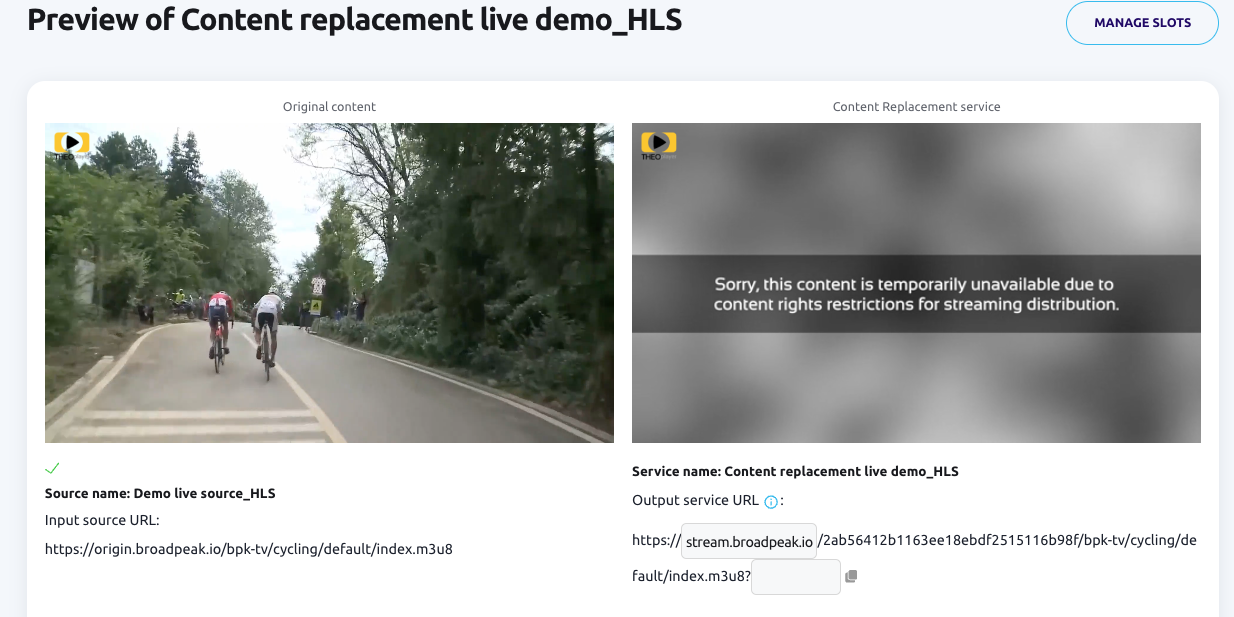Main concepts & Webapp overview
Quick tour of the main features available in the webapp
The Introduction talks about personalization of streams, through manifest manipulation.
At this stage, you may wonder how that works, and how the broadpeak.io interface will help you with this seemingly complex task.
You've come to the right place. In this section, we take you on a little tour to introduce you to the main concepts and how they appear in the broadpeak.io webapp.
Sources : the core material for any service you want to create
First and foremost, the broadpeak.io solution will need access to content. Whether it's the original content that you want to offer personalization on, or the alternate content that you want to replace it with or get inserted in the middle of it, we need fingers on it. We call all those Sources.
The webapp "Sources" button will give you access to the list of sources you have configured in your account.

From this view you can also easily create and configure new sources.
There are a variety of source types available, based on the use case at play:
| Type | Description | Can be used in... |
|---|---|---|
| Live | Linear streaming content | All services |
| Asset | Fixed duration media file | Content replacement & Virtual channel |
| Asset Catalog | Library of media assets | Ad insertion (for VOD) |
| Ad Server | Ad Decision Service | Ad Insertion & Virtual Channel (FAST) |
| Slate | Still picture (JPG) or mp4 | Ad Insertion (ad replacement) & Virtual channel, as a gap filler when no ads can be inserted |
Some sources are quite simple and are just defined by a URL to the original HLS or DASH stream. Some (like connections to ad servers) are a bit more involved.
On creation, the webapp will also check the availability and validity of the source with our input requirements, and offers a visual indicator and error message if an issue is found with it.
The source list in the webapp also allows you to:
- edit and reconfigure existing sources
- delete existing sources
- validate a stream without necessarily creating a source from it.
For more information about Sources, we invite you to visit the section Concept of Sources
Services : perform the stream manipulation
The next essential concept in the broadpeak.io solution is a Service.
A Service defines how the stream personalization is performed, by essentially connecting an original stream (ie. a source you have defined in the previous step) with the alternate content that needs to be substituted or inserted in it, together with other parameters.
The "Services" button in the menu provides you with the list of services you have configured in your account. And again, you can create and configure all aspects of your services from that view.

There is one service type for each use case:
| Type | Based on | Aims at... |
|---|---|---|
| Ad insertion | A live source or an Asset catalog & an ad server | Inserting or replacing ads in live or VOD sources |
| Virtual channel | A live source & optionaly an Ad server | Building a live channel with live, VOD assets and ads |
| Content replacement | A live source and a default replacement source | Replacing for some periods the live source with alternative VOD or live content |
Once a service is created, the manipulated stream is made accessible through a broadpeak.io streaming URL, which you will use in your web players, apps, web portals etc.

The webapp provides a view to let you preview a service, side by side with the original source.

Icons on the service list in the webapp allow you to
- Preview an existing service.
- Create and manage slots in Virtual channel and Content replacement services
- Edit and reconfigure an existing service
- Delete an existing service
- Pause or unpause an existing service
More details about services can be found in the service chapter of "Understanding broadpeak.io's behavior".
Categories : activate personalisation
Categories are a key feature of stream personalisation. They segment your audience to make it possible to deliver different content to them on a single requested stream and at the same time. They are closely linked to slot creation for Virtual Channel and Content replacement services. In case of ad insertion, the personalisation process is done by the ad server itself.

A category can be expressed in terms of age (Child, teenage, Young, Adult), geographical area (EMEA, APAC, Americas), device (Mobile, Web, TV) or any other form of segmentation that you can conceive. It includes a sub-category feature to handle zip codes.
When a category has been created, it can be associated to slots that define specific content to substitute in the original stream.
This is illustrated in this part of the documentation.
Account settings : open boundaries of your account
3 elements can be found in webapp's account setting page:
- Team members, to invite users to collaborate in your broadpeak.io's account
- API key to create tokens needed to use broadpeak.io's APIs. It's necessary as soon as you want to automate and scale up sources and services creation and update.
- Transcoding profiles, that are necessary for use of non transcoded sources (ads and slates) in ad insertion services. Currently, transcoding profiles are provided by broadpeak.io's Customer Success team. Please reach out to us to have your transcoding profiles set.
Updated 5 months ago
